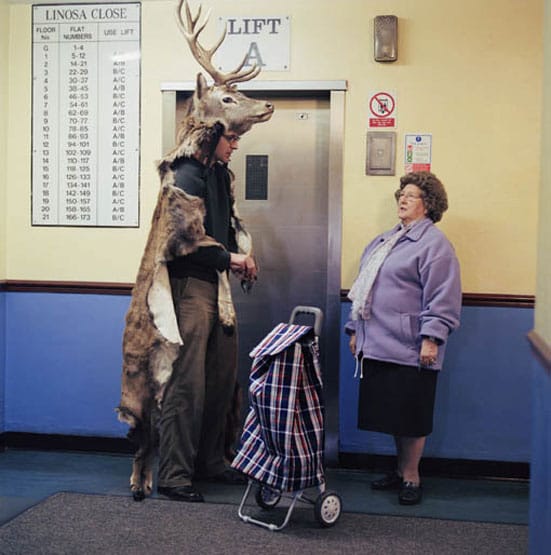27th June 2007 — 5th August 2007
By
2008 we will have reached a turning point in the history of humankind:
for the first time the majority of the world's population will inhabit
urban areas. As time goes on our relationship with the natural world
fades into collective cultural memory and our primary experience of
wildlife becomes a gaze through the glass of a city zoo. As a
counterpoint to this forgetting of our kinship with animals the video
pieces of Marcus Coates take us away from our anthropocentric
perspective and return us to a time when ritualistic acts called upon
animal spirits as a form of guidance; a time before rampant
industrialisation and its destruction of habitats. His current show at
The Whitechapel's Laboratory annex presents six works produced over the
last eight years, all of which probe the limits between the human and
the non-human and question the arrogance of our species in its
disregard for the environment.
Much of Coates' work is imbued with a strong sense of the
pre-historical, evoking a time when the human-animal symbiotic was far
more balanced. In Journey to the Lower World (2004), tribal drumming
accompanies the artist's shamanistic performance. Having gathered a
group of residents from a condemned tower block in Liverpool he
attempts to summon a solution to their plight of being involuntarily
re-housed. Dressed in a deerskin complete with head and antlers, he
stumbles around in a trance-like state, barking, while this small
audience watch with varying degrees of scepticism, amusement and
fright. Within the confines of a room in one of the flats he moves
awkwardly rubbing his antlers along the doorframe as his noises become
louder and his movements more intense. He sits down and drinks some
water which he lets fall from his mouth and spits onto the floor.
Returning from this other world he recounts the details of his
imaginary journey and explains what his encounters with animals along
the way signify for the group. It is not clear whether the residents
are convinced as he politely shakes their hands at the end. One cannot
help feeling some discomfort at the contrast between the harsh reality
facing the tenants and the art performance as a means of salvation.
In Dawn Chorus (2007) Coates projects the animal spirit onto others
rather than arousing it within himself. Having recorded a number of
different birdsongs in a Northumberland forest he then asked members of
the public to mimic those recordings at a sixteenth of their original
speed. The resulting film was then sped up so that although the song
plays correctly, the movements of each individual are much faster than
normal. Their heads move erratically and their chests expand and
contract at a speed similar to that of the bird they represent. The
merging of human and animal is extremely potent, vividly conjuring a
sense of the half-man half-beast from ancient mythologies.
Whilst touching on profound and serious aspects of the relationship
between humans and animals Coates also incorporates humour and a
playful element into his work. The two pieces which best exemplify this
are Stoat (1999) and Finfolk (2003). The first of these depicts the
artist attempting to walk wearing a pair of six inch stilts loosely
bound to his feet. He teeters on these crude implements in a way that
resembles the movements of the mammal on its hind legs. Here the human
imitates the animal but in a rather pathetic fashion. The second film
shows him assuming the guise of a seal emerging from a grey sea and
climbing a ladder to the top of a pier. He staggers about muttering a
nonsensical language that sounds like English swearwords delivered in a
Nordic accent. He spends a few minutes walking around in his tracksuit
and glasses before returning down the ladder and disappearing under the
water. As well as being playful there is undoubtedly reference to the
impotence of animals in the face of human aggression.
The destruction of natural habitats and the extinction of species are
obviously pertinent issues for Coates but it is only in one piece,
Britain's Bitterns (2007), that this is explicitly articulated.
Primarily he is interested in exploring the fringes of human nature
that give clues to our animal heritage, where we may be able to see
ourselves as part of the animal kingdom again rather than somehow
separate from it and superior to it. In his own words: '...you can't
escape your humanness, but the point of my work has been to explore the
degrees to which you can test that boundary and entertain the
possibility of becoming something else.'
AJL
Whitechapel
80-82 Whitechapel High Street
London E1 7QX
http://www.whitechapel.org
Open
Wednesday-Sunday, 11am-6pm

Marcus Coates
Journey to a Lower World
2004
Performance still
Courtesy of the artist, photo by Nick David